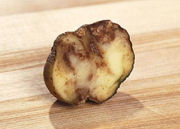Categories
Calendars
Guides
Reviews
Archive
Gallery
Articles
Ask Our Gardening Expert
Click here to set the weather dates to your area of the UK or USA.
How to Identify
Potato Blight The next stage is that the leaves curl and the whole potato
plant wilts and eventually falls over. This happens extremely
quickly and the whole process can take only a matter of days.
This will prevent the disease reaching the potato tubers under
the ground.
Burn the foliage immediately because this is a highly
infectious disease. The spores will live in the soil for a couple of years if
they are not destroyed. The same fungus also causes
Tomato Blight.
If the foliage is destroyed immediately Potato Blight is noticed, there
is a very good chance that the potato tubers under ground will be
unaffected. Growth of the potato tubers underground will be slow when
the foliage has been destroyed but they will be edible and will store
for some time in the ground. See the picture below to identify if the
potato tubers have been affected.
Treatment of Potato Blight
1. Destroy all infected plants by burning them. Do not plant potatoes
(or tomatoes) on the same patch of land without leaving an interval of
three years.
2. Spray potato and tomato plants with Bordeaux Mixture (available at
most garden centres) in May and June to help prevent infection.
As far as we are aware, eating potatoes infected with potato
blight will not cause serious medical problems. However the
picture on the right shows the effects on the tuber if the disease
is left to take its natural course. Its not as pretty sight I am
sure you will agree,
Crop Rotation
Avoid it occurring in subsequent years by good crop rotation and burning
all infected plants as soon as the disease is noticed.
The Potato Council have distributed two fact sheets on Potato Blight which can be found
here.
CLICK
HERE FOR NEXT POTATO PAGE Name: Jill Name: andrew raine Name: steve jones Name: Vicky McIntosh Name: mandy ![]()
Potato Blight
The first signs of potato blight are dark brown markings on the
edges of the potato plant leaves.
 The picture on the left (click it to enlarge it) shows the first
signs of potato blight. If you see this on a couple of your potato
plants the only course of action is to cut the plant down to ground
level immediately.
The picture on the left (click it to enlarge it) shows the first
signs of potato blight. If you see this on a couple of your potato
plants the only course of action is to cut the plant down to ground
level immediately.
Once you have it there is no treatment. To help avoid potato blight
there are two main courses of action:
The fungus which causes potato blight goes
under the name of Phytophthora infestans. It is spread by either wind or
rain in temperatures above 10oC (50oF)
Potato
Home Page
Previous
Potato Page
E-mail: jillhodgson19@yahoo.co.uk
Date posted: September 18, 2011 - 09:07 am
Message: Could you explain why my potatoes just turn all mushy why I cook them they havent grown very big even though they have been in since the end of April
E-mail: andrew.raine@hotmail.com
Date posted: June 23, 2011 - 05:44 am
Message: can i pick my potato crop now it seems a long time in flowering although i have plenty leaves and they are earlys
E-mail: sueelgey@hotmail.co.uk
Date posted: August 21, 2010 - 06:47 am
Message: Hi i have just dug up my salad potatoes and have noticed small white specks on them, they do rub off and the potato seems healthy, is this ok
E-mail: vmcintosh@talktalk.net
Date posted: August 20, 2010 - 02:12 pm
Message: My potatoes have grown very, very high leaves.
They were planted at the end of May and still flowering & growning bigger every week. Any advice?
E-mail: Private
Date posted: August 01, 2010 - 02:32 pm
Message: can you please tell me why my home grown potatoes split when i cook them.look forward to hearing from you.